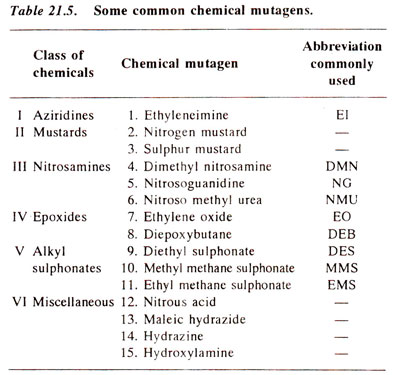Mutations can be artificially induced with the help of mutagenic agents, which can be broadly classified into two groups,
(a) physical mutagens - mainly
radiations and
(b) chemical mutagens.
Physical mutagens-radiations
Physical mutagens, are mainly radiations, although change in pH value (acidity) or temperature shocks may also induce mutations. Classification of, radiations commonly used for inducing mutations, is given in Table 21.3.

Ionizing radiations will cause ionization andwill force ejection of an electron from the atom it attacks. But the non-ionizing radiations like UV do not cause ionization, but cause excitation through energy transfer. Among ionizing radiations, more commonly X-rays, gamma rays, beta rays and neutrons are used for inducing mutations. X-rays are produced in a X-rays machine when energy charged particles like cathode rays (electrons) impinge on a suitable target like tungsten. Similarly gamma rays are produced when an unstable atomic nucleus like Cobalt-60 releases energy to gain stability. Beta rays (electrons) are produced from element like phosphorus and neutrons are produced in a nuclear reactor. Some of the sources of radiations and their importance in induction of mutations are given in Table 21.4.

The effect of a mutagen depends on its wave length and penetrance which are inversely correlated. Lower the wave length, higher the penetrance. This is why, ionizing radiations having lower wave length (λ)have high penetrance, and are thus used as acute radiation dose which means that the dose of radiation can be supplied quickly within a few minutes in one instalment. Such acute radiations are usually given to seed material. Contrary to this, some radiations are used in a chronic manner by keeping the living material like whole plants or seedlings in a gamma-garden where gamma rays, are continuously emitted at a very slow rate.
The mutagenic effect of X-rays was demonstrated in
Drosophila, for the first time in 1927 by
H.J. Mulier and in barley in 1928 (also later in maize) by
L.J. Stadler. As mentioned above, X-rays and gamma rays are ionising radiations and have high penetrance and can induce mutations in seeds. Ultraviolet rays, which are non-ionizing and have low penetrance are used for treatment'of material where nuclei are not located too far away from the surface. Since in seeds, embryo is present several cell layers away from the surface of the seed, it is not a suitable material for treatment with UV. However, in plants pollftn can be treated with UV, since every pollen has germinal nucleus, which can be altered. Similarly, cells of bacteria and other microorganisms can be treated with UV rays, since many of them are unicellular or one celled thick. However, the mutagenic effect of UV was discovered as early as 1930 by
Altenburg while treating
Drosophila eggs.
Chemical mutagens
Besides radiations, chemicals can also be used for inducing mutations. C.
Auerbach was the first to find that mutations can also be induced due to certain chemicals. She made this important discovery during World War II. The chemicals used for inducing mutations .were mustard gas, ethyl urethan, phenol, formaldehyde, etc.
Mustard gas was found to be highly mutagenic, and it was found to have a delayed effect. For instance, if treatment is given in first generation, mutations could be induced in second or third generation. A very long list of chemicals, which can induce mutations, is now available. During the last two or three decades
ethyl methane sulphonate (EMS) has been most extensively used for inducing mutations in microorganisms, higher plants and animals. Some of the important chemical mutagens are listed in Table 21.5.







